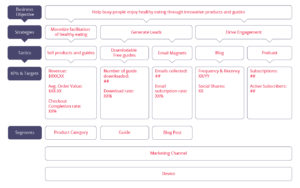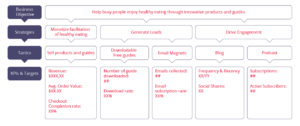You’ve probably heard this before, but it is true what doesn’t get measured can’t be improved. This is especially true when it comes to businesses and their websites. Websites are treated as a static piece, something that once it’s finished doesn’t need to be touched or improved. Your website should be more than that. It can be one of your most important and useful tools to grow your business, by attracting new customers, and engaging current ones to retain them. While it can be challenging to know where to start and to identify what isn’t working, improvements can be made more efficiently and have a bigger impact when you have the right data to guide the way.
Gathering the right data with Google Analytics
Google Analytics is a free tool that can really help you and your business, it can show you what visitors to your site are doing (or not). It is a complex tool that can be intimidating at first, with hundreds of reports, thousands of metrics.
You could spend hours digging into data, but that shouldn’t be the case. If you know exactly what you want to know, you can figure out which handful of metrics and reports can give you the answers and tell you a story you need to improve your site and business.
Figuring out what matters
First you need to figure out what you want to know. The following framework will guide you through breaking down your objective into strategies and tactics. It will also help you understand at a micro-level what strategies are adding the most value to your bottom line, and which can be improved. The framework combines methods used by Google, principals from The Lean Startup, and is influenced by Avinash Kaushik’s web analytics methodology.
Step 1 – Define your business objectives:
Defining your objective requires more thinking than you might anticipate. It is important you nail this down, because it is what is giving direction to your business and therefore your efforts. If you have a broken compass, you will never get to your destination on time.
When working with clients on their measurement plan or marketing strategy I try to avoid asking them directly about their business objective. It is very common that their first thought is they want to make money. It is understandable, its what we all want to do. If you think about it however, making money as an objective is not sustainable nor it drives strategic action.
I recommend to come up with a customer centric objective, one that guides all your strategies to benefit your customers. At the end of the day, if you want to make money you need customers, which you will need to attract and retain. But if you are not focused their benefit, why should they even buy from you?
As a case study to show you how this framework would look like, we will be using a hypothetical online store that sells curated cooking products and guides. They have defined their objective as “To help busy people enjoy healthy eating through innovative products and guides.”

Step 2 – Nail down your strategies
Once you have defined your objective and know where you are heading, you need to narrow down your focus and identify your current and possible strategies to accomplish the objective. You are already doing multiple things to get there – you may be trying to generate leads, attract new customers, keep the current ones, or make your employees happy and feel empowered. All of these things are strategies that can fulfill your business objective.

Step 3 – Break down your tactics
Here is where you start getting more granular by defining specifically what tactics you have or will implement on your website and marketing efforts to make that strategy successful. There is no limit to how many tactics you are implementing for a strategy, but each strategy should have at least one active tactic.
This chart will help you understand which strategy you are putting the most effort into and which may not be getting enough attention. Having more tactics for one strategy over another is neither good or bad, but this framework will provide you with the information to identify where gaps may exist.
As one of their main strategies our hypothetical company needs to monetize the facilitation of healthy eating that they are offering, they do this by selling curated products and paid guides that will help their customers. They generate leads through free guides that customers and prospects can download and they also have email magnets to collect emails in their blogs. Their blogs are not only there to collect emails, but they are also looking to be a source of information and drive engagement with their followers.

Step 4 – Select Key Performance Indicators (KPIs) & Targets
Each one of the tactics you’ve listed down will need, a metric or set of metrics that will tell you if it’s working or not. KPIs or Key Performance Indicators are commonly used to define these important metrics. The KPI will depend mostly on what people are able to do on your website. In an ecommerce website a KPI can be the revenue generated, while for a content publishing strategy you can look into engagement and frequent visitation.
If this is your first time doing this, identifying targets for each KPI can be challenging. You could use historical data or even industry benchmarks. One of the best and most relevant ways to define targets for your KPIs is to make them more tangible, by understanding how they affect your bottom line.
For example, if you know that out of every 5 leads you get 1 client, and you need 5 new clients a month to reach your growth target, then you could say your target is to attract 25 leads a month. You could also look at the same example and decide that you want to improve is the conversion rate. Instead of converting 20% of your leads you are working towards converting 40%.
Don’t worry about setting those perfectly, you can change them at any time if they have become too easy to achieve, or impossible to reach.
Step 5 – Identify your Segments
It is important to know and have it top of mind that data as an aggregate can be deceiving. Especially when you only look at averages, as they aren’t tell you the full story.
There are many ways you can segment your data to get a deeper understanding of how your customers and users behave on your website. There are basic segments that you might want to analyze such as the marketing channel that brought them to the site, the device they are using, or demographics. More complex ways to segment data is by creating cohorts of people based on their behaviours like people who purchased, or people who have downloaded your app and used it X number of times. As you can see there are infinite ways to segment data, which is why you need to identify and define the most relevant segments for you and your business KPIs.
Hypothetical company wants to analyze each marketing channel to identify which is being the most efficient for each one of the different tactics. They also want to know if there are certain tactics that perform better on desktop or mobile. There are specific segments that only apply to one tactic – such as analyzing the revenue brought in by each product category.

Continue to optimize your framework and your business
Going through this framework is a lot of work, and requires thought and brain power. In many cases you won’t be doing it yourself, and you will want input from others – especially when they are the ones managing a strategy or tactic that you’ll be measuring.
There will always be room for improvement and optimization of your newly created measurement framework, but you now you have a better understanding of what data points matter and what to look for to improve your business.
